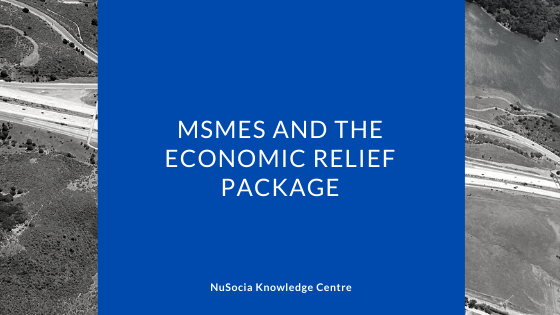After much anticipation and build up, Government of India announced its economic stimulus package for economy impacted by Coronavirus enforced lockdown. With the announcement out, TV debates and WhatsApp memes have been fighting it out on how good is the “20 lakh crore” Economic Package announced by the government.
We dig into the MSME aspect of it – researched through views of various experts and presenting herewith a curated content for easy understanding of the same.
Background
Earlier, India has classified the sector into Micro, Small, and Medium Enterprises (MSMEs) based on the kind of investments in plant and machinery. Subsequent governments have offered them incentives to aim for growth, it being a large employer and significant contributor to the economy. Incentives like cheap loans, fewer compliance standards, tax benefits, and host of other freebies were available for the sector, with the catch that as you keep growing bigger from Micro to Small and Small to Medium, the incentives keeps getting lesser. Sounds logical so far !
Now, here comes the human nature. A small enterprise with incentives aims for the growth, starts achieving it and want to expand and therefore invests in more plant and machinery – and then realises it’s getting shifted from Small to Medium classification and thereby stands to lose some of the benefits. The business brain figure out ways to hide these investments (as that is the classification criteria) on accounting books. Government was thus loosing potential revenue there and it was difficult for government / tax authorities to spend additional resources in verifying the claims. So government started working on a proposal to change the classification criteria. With GST in place, they figured out that total revenue would be a verifiable measure. Also, it brings in service sector SMEs and manufacturing SMEs to same platform.
Industry body of MSMEs, however, lobbied and urged the government to keep the classification criteria intact for past many months.
The Changes
The current economic scenario provided government with an opportunity to bring in some long pending reforms. Along with the package, the government finally introduced turnover as an additional criterion. They also increased the investment limit in each level to ensure MSMEs don’t get deprived of benefits too soon.

Besides the classification, the government also wants to get additional funding into the sector so, they created Fund of Funds – wherein government puts together a mother fund with 10,000 crores, then disburse the funds from the mother entity to smaller daughter funds in a piecemeal fashion and try and get other investors on-board these smaller funds. However, the challenge is that VCs are not interested in traditional MSMEs because there’s no scope for exponential growth there, owing to the large scale pre-existing debts. Most of them are largely reliant on banks and new loans to tide over the same. In fact, by 2018, thousands of MSMEs were on the verge of default with close to 80,000 crores worth of problem-loans.
The tendency of taking new loans to overcome past loans is in the hope that economic scenario improves and business do very well. The bigger hope that the banks have is that Indian economy keeps its booming pace and they lend big time to large growing corporate, so the problem of these small loans to MSMEs, which turn bad, remain a small problem. However, the coronavirus pandemic poured cold water on both the above expectations. With no economy revival in sight due to extended lockdown and muted customer demand – banks don’t want to offer another lifeline by extending new loan, without which many MSMEs would eventually die, result in spike in defaults.
Therefore, another important part of government announcement was the announcement of 3 lakh crore worth of collateral—free loans for businesses, including MSMEs. To illustrate, for a business with an existing loan burden on hands, banks will now extend new loans (of up to 20% of the total loan outstanding) to enable restart the operations, with 4 years to repay this loan. Repayment obligations won’t kick in until the end of the first year. The government will stand as guarantor in case of default and they will compensate the banks in full (interest and principal). So technically, banks should be more willing to lend to these institutions now.
Additionally, government is now disallowing all global tenders of up to 200 Cr. effectively handing over the entire revenue pie to MSMEs in India.
Will these measures help – only time will tell. Until then…you have a choice. A choice to remain hopeful that it works and contribute to the hope in whatever way you can or to join the TV and WhatsApp debates with memes and often half-baked facts. Atleast the government wants you to be self-reliant in making that choice.
A NuSocia Research And Knowledge Team Curation !




